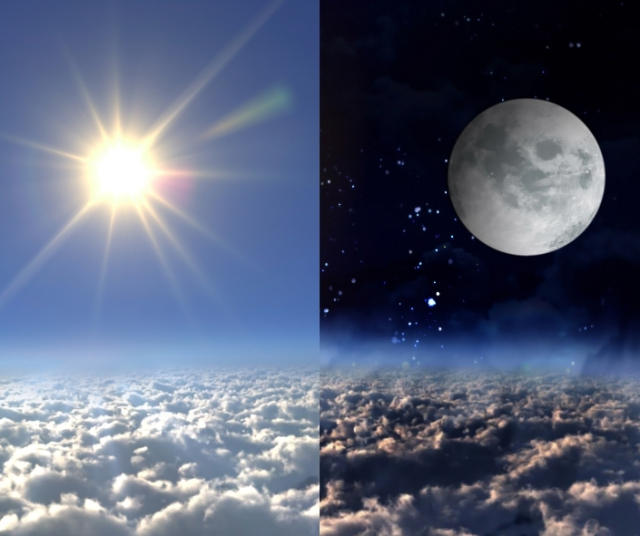The relationship between the Moon and Earth's climate is a fascinating topic that has intrigued scientists, observers, and poets for centuries. While the Moon's direct influence on climate is relatively small compared to other factors such as solar radiation and atmospheric patterns, several lunar phenomena have significant impacts on Earth. In this article, we will explore in depth the relationship between the Moon and Earth's climate, analyzing how lunar cycles affect various climatic and atmospheric aspects.
Moon phases and weather.
The lunar phases, which run from new moon to full moon and back, have an indirect but noticeable effect on Earth's climate. During a full moon, when the Earth is between the Sun and the Moon, lunar light can contribute to a slight increase in nighttime temperatures. On the other hand, during the new moon, when the Moon is aligned with the Sun and Earth, the nights tend to be darker and cooler. These subtle changes can influence local cooling and warming patterns, especially in areas with low cloud cover.
Tides and coastal climate.
One of the most obvious influences of the Moon on Earth are the tides, which are caused by the gravitational pull of the Moon and the Sun on Earth's oceans. While tides themselves do not directly affect atmospheric climate, they can influence coastal weather conditions by affecting the distribution of water temperature and the flow of ocean currents. Additionally, extreme tides, such as spring tides during full moons and new moons, can contribute to coastal flooding and erode shorelines.
Atmospheric effects.
The atmospheric effects of the Moon are an ever-evolving area of study that encompasses a wide range of subtle but potentially significant phenomena. Although the Moon does not have a significant atmosphere like Earth, some lunar phenomena can have indirect effects on Earth's atmosphere.
One of the most studied atmospheric effects is the change in barometric pressure during lunar eclipses. During a total lunar eclipse, when the Moon passes through the Earth's shadow, a slight drop in atmospheric pressure has been observed at some weather stations. This change may be related to the absorption of solar radiation by the Earth's atmosphere during the eclipse, resulting in a slight atmospheric contraction. However, these changes are extremely small and difficult to detect without sensitive measurement equipment.
Another atmospheric effect associated with the Moon is the ionization of the upper atmosphere during lunar eclipses. During a total eclipse, solar radiation that normally ionizes the upper atmosphere is blocked, which can result in a temporary decrease in atmospheric ionization. This, in turn, can affect the propagation of high-frequency radio waves and the formation of auroras in the polar regions. However, the effects of atmospheric ionization during lunar eclipses are still debated and require further research.
In addition to lunar eclipses, other astronomical events related to the Moon, such as lunar phases and the relative position of the Moon in the sky, can also have minor but detectable atmospheric effects. For example, some studies suggest that lunar phases can influence cloud formation and precipitation distribution by affecting incident solar radiation and regional atmospheric circulation. However, these effects are difficult to separate from other climatic factors and require more research to be fully understood. Overall, the Moon's atmospheric effects are a fascinating area of research that highlights the complex interaction between the Earth, the Moon, and the cosmos as a whole.
Climate and cultural astronomy.
In addition to its physical influence on the climate, the Moon also plays a significant role in many human cultures and traditions. Since ancient times, lunar phases have been associated with agriculture, fishing, hunting and other aspects of daily life. In many cultures, lunar calendars are used to determine planting and harvest seasons, as well as to mark religious celebrations and holidays. This connection between the Moon and human activities reflects the deep interdependence between nature, climate and culture.
Future research and challenges.
Despite decades of research, there is still much to learn about the Moon's influence on Earth's climate. Scientists continue to study how lunar cycles affect weather and climate patterns at different scales, from local regions to global atmospheric circulation. However, this research faces numerous challenges, including the complexity of Earth systems, natural climate variability, and the need for accurate, long-duration data.
The influence of the Moon on Earth's climate is a complex and multifaceted topic that ranges from subtle changes in nighttime temperatures to the more obvious effects of coastal tides. While the Moon represents only one of the many factors that affect Earth's climate, its influence is undeniable and fundamental to understanding the complex dynamics of our planet. By continuing to research and explore this cosmic relationship, we can improve our understanding of Earth's climate and its impact on life on Earth.






